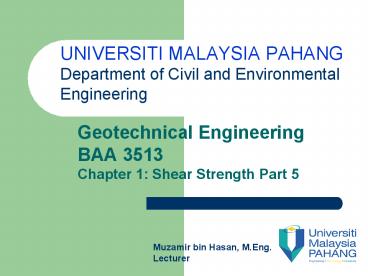Geotechnical Engineering - PowerPoint PPT Presentation
1 / 29
Title: Geotechnical Engineering
1
UNIVERSITI MALAYSIA PAHANG Department of Civil
and Environmental Engineering
- Geotechnical Engineering
- BAA 3513
- Chapter 1 Shear Strength Part 5
Muzamir bin Hasan, M.Eng. Lecturer
2
Example 7.3 (page 188)
- Two similar clay soil specimens were
preconsolidated in triaxial equipment under a
chamber pressure of 600 kN/m2. Consolidated-draine
d triaxial tests were conducted on these two
specimens. Following are the results of the
tests Specimen 1s3100kN/m2 - (?sd)f410.6kN/m2
- Specimen 2s350kN/m2
- (?sd)f384.37kN/m2
- Determine the shear strength parameters for the
samples.
3
Solution
Specimen 1
Specimen 2
4
Solution
Specimens are overconsolidated, so
Specimen 1
Specimen 2
5
Solution
By subtracting the equations
6
Solution
Substituting ø112
7
Unconsolidated-Undrained (UU) Test
- u uc ud but since uc B s3 and ud A sd so
therefore, u B s3 A sd B s3 A (s1 - s3) - This test is conducted on clay specimens, and
depends on a very important strength
characteristic if the soil is fully saturated. - The failure envelope become horizontal, and hence
f 0 and ?f cu where cu is the undrained shear
strength and is equal to the radius of the Mohrs
circles.
8
Unconsolidated-Undrained (UU) Test
9
Unconsolidated-Undrained (UU) Test
- The reason for obtaining the same added axial
stress (sd)f regardless of the confining pressure
can be explained as follows. - If a sample (No. 1) is consolidated at a chamber
pressure s3 and then sheared to failure without
allowing drainage, the total stress conditions at
failure can be represented by Mohrs circle P in
the figure. - The pore pressure developed in the sample at
failure is equal to (ud)f. Thus, the major and
minor principal effective stresses at failure
are, - s1 s3 (sd)f - (ud)f s1 - (ud) f and s3
s3 - (ud) f
10
Unconsolidated-Undrained (UU) Test
11
The Unconfined Compression Test
- A special type of UU test that is commonly used
for clay specimen. - s3 0
- Axial load rapidly applied to the specimens to
cause failure. - At failure the total minor principal stress is
zero and total major stress is s1
12
(No Transcript)
13
mm
14
The Unconfined compressive (UC) test on
saturated clays
15
General Relationship of Consistency and
Unconfined Compression Strength of Clays
16
The Stress Path Concept
- A convenient way of plotting triaxial test data
is through diagrams called stress paths. - A stress path is a line that connects a series
of points, each of which represents a successive
stress states experienced during a test.
17
The Stress Path Concept
- Lamb (1964) suggested a new coordinate system of
p versus q where,
18
The Stress Path Concept
- Consider a normally consolidated clay subjected
to an isotropically consolidated-drained triaxial
test. - At the beginning of the test, the deviatoric
stress s1 s3 s3, so
19
The Stress Path Concept
- and the p and q will plot as point I in the
figure on the next slide. As the load is
increased, the deviatoric stress s1 s3 ltsd
and s3 s3, and the Mohr circle A corresponds
to that state.
20
(No Transcript)
21
The Stress Path Concept
- These two equations plot as point D at the top
of the Mohr circle A. - Each successive plot of p and q will continue
this straight line that is at an angle of 45
with respect to the p axis. - Eventually we will reach the point D on the Mohr
circle B, and the sample fails (it has reached
the modified failure envelope). - From this, q ' p ' tana
22
(No Transcript)
23
Sensitivity and Thixotropy of Clays
- For naturally deposited clay soils, unconfined
compression strength is reduced greatly when the
soils are tested after remolding without any
change in moisture content. - This property is called sensitivity.
24
Sensitivity and Thixotropy of Clays
25
Sensitivity and Thixotropy of Clays
- The sensitivity ratio of most clays ranges from
about 1 to 8 however, highly flocculent marine
clay deposits may show sensitivity ratios ranging
from about 10 to 80. - There are some clays that turn to viscous fluids
upon remolding. - These are found mostly in the previously
glaciated areas of North America and Scandanavia.
- These clays are referred to as quic clays.
26
Sensitivity and Thixotropy of Clays
- Rosenqvist (1953) classified clays on the basis
of their sensitivity.
27
(No Transcript)
28
Sensitivity and Thixotropy of Clays
- The loss of strength of clay soils due to
remolding is primarily due to the destruction of
the clay particle structure that was developed
during the original process of sedimentation. - If, however, after remolding a soil specimen is
kept in an undisturbed state (that is, without
any change of moisture content), it will continue
to gain strength with time. - This phenomenon is referred to as thixotropy.
29
Homework
- Problems 7.14
- Submit next class































